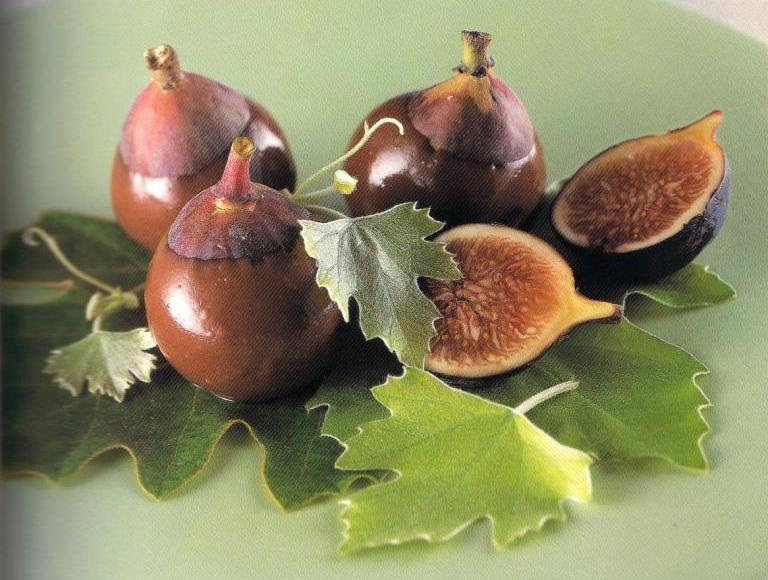 I had a wonderful meal a few nights ago, at abckitchen in New York City, sponsored by the California fig advisory board. I am crazy about figs yet know very little about them. Dried figs were what we ate at home; fresh figs were a luxury. While we were a table of "Eves" the other night -- no "Adams" -- we ate like queens and I never imagined fig season would be welcomed with such open arms. Fresh, perfectly ripe, Black Mission figs dotted the menu that I shared with a round table of food editors from Oprah, Reader's Digest, Weight Watchers, et al. It was the ultimate girl's night out. I loved the black mission figs draped with prosciutto and set in a nest of balsamic-spiked wild arugula; I swooned over the honey-glazed turnips with figs, rosemary and lemon, and really enjoyed the individual baked Alaskas with fig ice cream and cinnamon spice cake. Clearly the chef, Dan Kluger, loves figs, too. The ancients considered figs to have magical, medicinal powers, an idea supported by scientific evidence that figs were cultivated, in Jericho, more than 11,000 years ago.The great writer Lawrence Durrell once said about olives, "a taste older than water." The same could be said about figs.
I had a wonderful meal a few nights ago, at abckitchen in New York City, sponsored by the California fig advisory board. I am crazy about figs yet know very little about them. Dried figs were what we ate at home; fresh figs were a luxury. While we were a table of "Eves" the other night -- no "Adams" -- we ate like queens and I never imagined fig season would be welcomed with such open arms. Fresh, perfectly ripe, Black Mission figs dotted the menu that I shared with a round table of food editors from Oprah, Reader's Digest, Weight Watchers, et al. It was the ultimate girl's night out. I loved the black mission figs draped with prosciutto and set in a nest of balsamic-spiked wild arugula; I swooned over the honey-glazed turnips with figs, rosemary and lemon, and really enjoyed the individual baked Alaskas with fig ice cream and cinnamon spice cake. Clearly the chef, Dan Kluger, loves figs, too. The ancients considered figs to have magical, medicinal powers, an idea supported by scientific evidence that figs were cultivated, in Jericho, more than 11,000 years ago.The great writer Lawrence Durrell once said about olives, "a taste older than water." The same could be said about figs.
California produces 100 percent of the country's dried figs and 98 percent of its fresh figs, of which more than half get shipped to Canada. The season begins mid-May and extends, surprisingly, all the way to mid-December; mid-August is when it's in full swing. In fact, more than 20 years ago, the first day of my new job working for the legendary restaurateur, Joe Baum, on August 15, I prepared a "birthday breakfast" for him -- one of my homemade Venetian wine cakes (made with olive oil, red wine, rosemary and lemon) and chose, one by one, 24 perfectly ripe fresh figs from the Union Square Farmer's Market, near our office. The figs had been warmed by the sun and were a stunning accompaniment to the cake and coffee. It was one of my favorite "fig memories." At dinner the other night, we asked, one by one, to share our favorite fig memory. It was lovely to hear the responses: from eating them off a tree on a honeymoon to a wistful sharing of a father's fig tree that bloomed only after he had passed away. One woman at the table had never had a fresh fig and was deemed "fig virgin" of the evening.
Apparently there are five primary varieties of figs grown in California, yet there are hundreds and hundreds of species grown around the world. The five in the U.S. are Black Mission, calimyrna, kadota, brown turkey, and sierras. And there is a newer variety known as "tiger fig" with a green-striped overcoat that revels a raspberry-red interior. I liked the way that Karla Stockli, the CEO of the fig board, described the figs -- as though describing the nuances of wine! Black Mission figs with purple-black skin and deep earthy flavor are likened to a cabernet. Calimyrna, with its pale yellow skin and buttery, nutty flavor are (you guessed it!) chardonnay-like; Kadota has similar notes to sauvignon blanc; brown turkey with a light purple skin and floral notes are likened to pinot noir, and sierra with their light-colored skin and fresh, sweet flavor are Riesling-esque.
And it's good to note that three to five fresh or dried figs provide 5 grams of dietary fiber (or 20 percent of the daily value.)
The photo here is a recipe for fresh figs that I created a decade ago for my book, Desserts 1-2-3 (which landed on the L.A. Times "Hot List" and chosen as one of the best books of the year by Food & Wine Magazine). Dipped in a thin coating of melted chocolate and yogurt, my husband named them "figs in nightgowns." I will share the recipe tomorrow. They are insanely delicious.